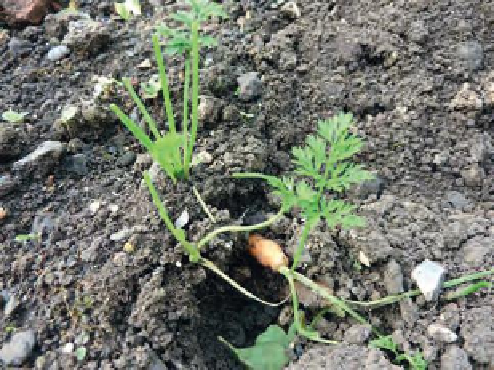Agriculture Reference
In-Depth Information
Introduction
Why do we need to control pests? Most gardeners
will have seen aphids on their roses and broad beans
and wanted to achieve some level of control before
the pest becomes unsightly, or damages the plants.
This chapter describes some of the pest species seen
in gardens, from the mammals such as rabbits down
to the tiny nematodes. In addition to descriptions of
damage and control, the
link between life cycle and
controls
is highlighted in an attempt to make the
control more meaningful. Control measures and their
impact on humans and the environment are dealt with
in more detail in Chapter 16.
Figure 18.2
Rabbit damage on carrots
Mammal pests
There are relatively few mammal pest species in
Britain and Ireland, but they can cause serious damage
to plants in the garden and horticultural units. The
rabbit, grey squirrel and mole are described below.
in one year, commonly in the months of February to
July. The young are blind and naked at birth, but emerge
from the underground nest after only a few weeks to
find their own food. Large burrow systems (warrens)
penetrating as deep as 3 m in sandy soils, may contain
as many as 100 rabbits. Escape or bolt holes running off
from the main burrow system may allow the rabbit to
escape from predators such as weasels.
Control
. Rabbit control is, by law, the responsibility of
the land owner. Preventive measures are effective.
Three physical control measures may be mentioned.
Brick walls, or wire mesh
fencing
with the base
dug 30 cm underground and with this base facing
outwards at an angle, represent an effective barrier
to the pest. Sturdy sheet
plastic guards
coiled round
the base of exposed young trees prevent ring-barking.
Repellent chemicals such as
aluminium ammonium
sulphate
,
sprayed on bedding displays and young
trees, deter the pest. Rabbits are deterred by some
garden plants. Six resistant examples of the 150 listed
species are
Agapanthus
, dahlia, snowdrop,
Clematis
,
Berberis
and
Weigela.
A
pest
is a mammal, bird, insect, mite, mollusc
or nematode that is damaging to plants.
The rabbit (
Oryctolagus cuniculus
)
The rabbit (Figure 18.1) is common in most countries
of central and southern Europe. It was introduced
to Britain and Ireland around the eleventh century
by the Normans, and became an established pest in
the nineteenth century. In some countries where it
was introduced, such as Australia, it has become an
extremely damaging pest.
Damage
. The rabbit may consume 0.5 kg of plant food
per day. Young turf and cereal crops are the worst
affected, particularly when in the seedling stage, and
quite large areas may be destroyed. The resulting
bare areas of fine turf on golf courses may allow
lawn weeds such as yarrow (see p. 221) to become
established. Rabbits may move from cereal crops
to horticultural holdings. Stems of top fruit (such as
apples) and ornamental shrubs and trees may have
the cambium, phloem and xylem tissues interrupted
(
ring-barked
), particularly in early spring when other
food is scarce. Vegetables such as carrots, lettuce,
annual bedding plants and herbaceous perennials are
common targets for this pest (Figure 18.2).
Life cycle
. The rabbit's high reproductive ability enables it
to maintain large numbers, even when continued control
methods are being used. The female (doe), weighing
about 1 kg, can reproduce within a year of its birth, and
may have three to five litters of three to six young ones
The grey squirrel (
Sciurus
carolinensis
)
The grey squirrel was introduced into Britain and
Ireland from North America in the late nineteenth
century, at a time when the native red squirrel
population was being reduced by disease. The grey
squirrel (Figure 18.3) has become dominant in many
areas, but the red squirrel survives, particularly in
central and southern Scotland, the Lake District,
central and north Wales, and the Isle of Wight.
Damage
. The horticultural damage caused by
grey squirrels varies with each season. In spring,
germinating bulbs may be eaten, and the bark of


